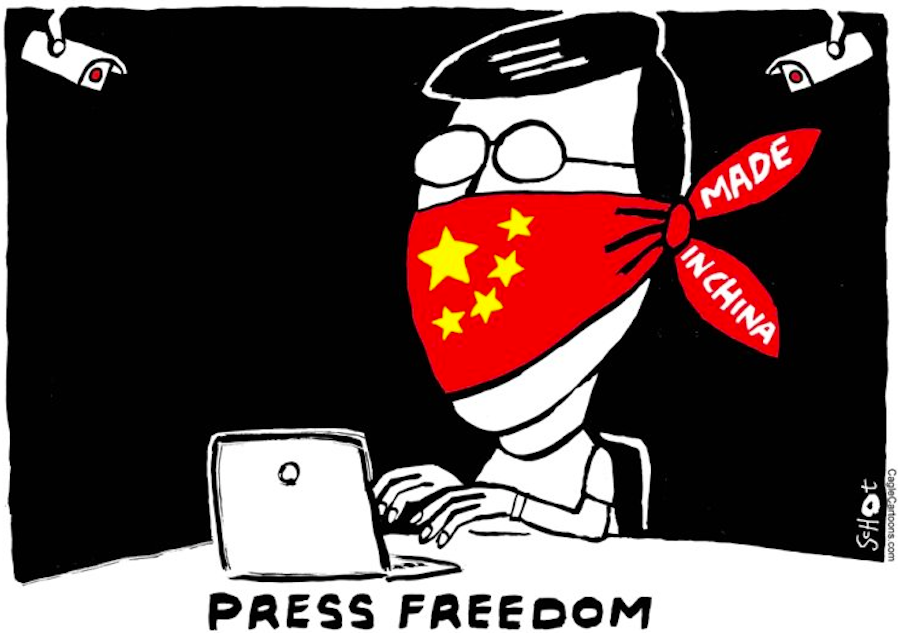Indian Prime Minister Atal Bihari Vajpayee returns today, 27 June 2003, from a six-day visit to China. Several agreements were signed during the visit that attempt to address the most crucial matter of contention between both countries over the last half a century, their manner of co-existence in the Tibet-Himalayan region. One of the agreements, which reiterates that India “recognises that the Tibet Autonomous Region is part of the territory of the People’s Republic of China”, attracted much public attention, but is not, in fact, a departure from former policies towards the Dalai Lama and the Tibetan refugees in India. A further agreement, stating that high-level envoys from both countries will foster “the framework of a boundary settlement”, indicates that little actual progress has been made in this regard so far. The most substantial agreement facilitates visa procedures for short-term trade and announces the re-opening of the Tibet-India trade route, via the Nathu La pass, which separates the Tibet Autonomous Region (TAR) from the Indian state of Sikkim. This potentially means a boost for local economies in the TAR and north east India. Unlike India’s reiterated statement on the status of Tibet, the agreement falls short of formally recognising Sikkim as a part of India. However, it tacitly acknowledges India’s control over the former Himalayan principality. These developments could indicate that both countries are gradually moving towards a revival of the once intense cross-border trade relationships and thereby ultimately towards a solution to the border dispute based on the existing situation. It remains to be seen how this will impact future developments of the Tibetan question.
“History should be respected”
After India’s independence in 1947 and the emergence of the People’s Republic of China (PRC) in 1949, both countries regarded themselves as leaders of an emancipated developing world and strained to develop a cooperative rather than a competitive relationship. However, their deeply divergent views on Tibet and the Himalayan region proved to be a major obstacle. Whereas both countries made ‘respect for history’ the leitmotif of their policies in the region, they appeared to have different interpretations of what this actually meant. India sought a modus vivendi on the basis of the then existing status quo, while China claimed what it perceived as its ‘historical rights’ over the region. China was particularly resentful of the tripartite convention held between Chinese, British-Indian and Tibetan delegates in the North Indian hill-station of Simla in 1914. The convention established a fuzzy autonomous status for Tibet and defined its border with India widely on the basis of British surveys. China never ratified the treaty. By 1949, the PRC claimed all Tibetan territories as Chinese. This claim included the Aksai Chin in the western sector of the Indo-Tibetan border, a vast but uninhabited region used by both Tibetan and Ladakhi nomads as summer pasture, and set the border in the eastern sector at the foot of the Himalayas rather than on the British established MacMahon-Line, which runs through the peaks.
In 1950-51, the advance of the People’s Liberation Army (PLA) ended Tibet’s de facto independence. India remained relatively passive during this episode, and Indian Prime Minister Nehru tried to accommodate China by signing a treaty in 1954 that acknowledged Tibet as part of China. The treaty stipulated the establishment of an Indian consulate in Lhasa and the practice of border trade, but it failed to demarcate the border since India refused to accommodate Chinese territorial claims. Nehru was heavily criticised for having ‘sacrificed Tibet on the altar of the Sino-Indian friendship’ without any real gains for India.
Indeed, China maintained its claims which were best expressed by the then Chinese foreign minister Zhou Enlai, who is quoted as saying “Tibet is China’s right hand and Ladakh, Nepal, Sikkim, Bhutan and the North East Frontier Agency (NEFA) [i.e. the five regions, countries and former principalities on the southern slopes of the Himalayas, NEFA being today’s Indian state Arunachal Pradesh] are this hand’s fingers”. Relations between the two countries first hit a low point as the Chinese repression of the Tibetan uprising of March 1959 caused considerable concern in India and the Dalai Lama, together with a substantial number of Tibetan refugees, took asylum in India. China’s subsequent closure of the Indo-Tibetan borders and its refusal for several years to let Tibetan Muslims of Indian origin leave Tibet, as they were entitled to by the treaty of 1954, brought bilateral relations even lower. The secret construction by China of a strategic road through the Aksai Chin between Tibet and Xinjiang ultimately led to the Sino-Indian border war of 1962. In the course of the war, the PLA, which faced ill-equipped and unprepared Indian troops, realised parts of China’s territorial claims, in particular complete control over the Aksai Chin.
Further complications arose in 1974-5, when Sikkim was annexed by India. The principality had been a British protectorate since the end of the 19th century and then an Indian protectorate after 1947. India’s intervention occurred in the context of a civil-war-like situation in Sikkim. Though at the margin of the framework defined by international law, the accession of Sikkim to the Indian Union was later endorsed by the democratically elected Sikkimese parliament. Until the end of the 19th century, Sikkim had been a tributary state to Tibet, which apparently provides the basis for China’s particular interest in it. China has refused to accept the legality of India’s ‘occupation’ of Sikkim. Sikkim is still listed as a separate independent state on the website of the Chinese Ministry of Foreign Affairs, with the description: “The Chinese Government does not recognize India’s illegal annexation of Sikkim.”
“Sorting out controversial issues” and “economic intercourse”
Vajpayee’s visit to China, the first by an Indian Prime Minister in a decade, explicitly aimed to establish common ground between the two countries and ultimately to resolve existing differences. India and China have now concluded a series of agreements which affirm these intentions, but in themselves do not yet solve the existing problems. The declaration that Tibet is a part of China is merely a reiteration of what has been official Indian policy since 1954. India granted asylum to the Dalai Lama in 1959 under the condition that he would refrain from ‘political activities’. In an initial reaction to Vajpayee’s statement, Tashi Wangdi, representative of the Dalai Lama in the Indian capital New Delhi, states “India’s position is known to us (…) we have enjoyed full freedom here (…) Prime Minister Vajpayee (…) has been speaking on Tibet for 50 years now and he knows the issue very well. We are sure he will keep in mind the interests of all (…) we don’t feel nervous about it”. Long term advocates of the Tibetan cause, like defence minister George Fernandes, occupy high posts in Vajpayee’s government.
The re-opening of the Nathu La pass has been demanded by the local authorities in Sikkim, the bordering Darjeeling Autonomous Hill Council and the TAR since the 1980s. However, India and China rejected the demand for many years due to strategic and political considerations. While Beijing feared an implicit recognition of Sikkim as Indian territory, TIN sources mention that security advisers in New Delhi warned against opening an ‘invasion route’ into a region perceived as militarily vulnerable. In the TAR, the demand has often been reiterated in recent years in connection with the development of tourism, which the authorities have earmarked as a future ‘staple industry’. The Kalimpong-Lhasa route is about one third shorter than the Kathmandu-Lhasa axis that currently links Tibet with South Asia and it is geographically more easily accessible. Historically, this trade route and its extension to the port of Calcutta (Kolkotta) in the Bay of Bengal have generated considerable wealth in Central Tibet and north east India. Its closure in 1959 created dead-ends on both sides of the border and marked the beginning of a period of economic regression. In a recent article in “Ethno-National Studies” the Chinese economist Wu Jianguo argued that the development of Tibet’s border trade and opening up of South Asian markets would be beneficial to the TAR’s development as well as to the “adjustment of Tibet’s industrial structure and development of new industries”. The author also stipulates that the opening would “have great significance for getting Tibet a leap over development” and would transform Tibet into a “bridge” for the transfer of goods from inner China to South Asia.
The new agreements also mention the eventuality of opening further crossing points in other parts of the Tibet-India border. The region of Ladakh in North West India would be one possible candidate. Though the potential for trade would be limited in Ladakh, the Kailash region, one of the most popular tourism spots in the TAR, is much easier to access from Ladakh than from Lhasa or Nepal. This would open opportunities for the development of tourism in Western Tibet, particularly since Kailash is considered a holy mountain by Hindus and a growing number of Indians wish to visit the region for pilgrimage.
The potential economic benefits for the Tibet-Himalayan region from an opening of the borders is obvious. On a political level, future cross-border economic intercourse would also create incentives for the establishment of a permanent and mutually agreed border demarcation. In an interview with the Indian newspaper “The Hindu” Chinese Prime Minister Wen Jiabao made conciliatory statements about a possible future settlement of the border dispute on the basis of “reciprocal adjustments”. This raises the question of which adjustments might be realistic.
In the West sector of the border, the likelihood that China would give up the Aksai Chin, a region which it considers as strategically vital, does not appear realistic. In the East sector, China made only small territorial gains in 1962, but it has consistently refused to accept the MacMahon line. It appears thus that, having achieved its most important strategic goals already in 1962, China’s persistent demand for a border settlement has more to do with the political-symbolic value of ‘regaining face’ after what Wen Jiabao called in another interview on 23 June the “aggression and humiliation” which “the Chinese nation (…) suffered (…) to the fullest extent” (an allusion to China’s perception of its historical treatment in the region). A mutually acceptable final border settlement is therefore unlikely to be anything else but a mere acknowledgement of existing facts.
It is remarkable that China holds up the fiction of an independent Sikkim, but does not raise territorial claims to any part of the former Himalayan principality. Sikkim, though very proud of its cultural and historic specificity, has a democratically elected government that fully supports the integration of the state within India. In Sikkim itself, the demand for an ‘independent Sikkim’ is, in any event, marginal. Seen in this perspective, China’s refusal to acknowledge the integration of Sikkim within India appears as a bargaining point for future Sino-Indian negotiations on a permanent border settlement, particularly since the occupation of the Aksai Chin by China in 1962 created wounds in India which still have not fully healed. Furthermore, China’s persistence on Sikkim might be a means of maintaining pressure on India regarding its harbouring of the Dalai Lama and the Tibetan refugees, particularly the Karmapa whose main monastery outside Tibet is in Sikkim. Since his arrival in India in 2000, the Karmapa has not been given authorisation to travel to Sikkim by the Indian authorities, despite invitations from the Sikkimese State government.
China seems to be acting according to the strategy outlined by Wu Jianguo in his article: “Since India is carrying out two different kinds of strategies [(i.e. confirming China’s claim on Tibet while harbouring the Dalai Lama)], it would be helpful for seeking common ground while reserving differences, and for creating a good atmosphere for sorting out controversial issues to develop bilateral trade and economical intercourse.”









